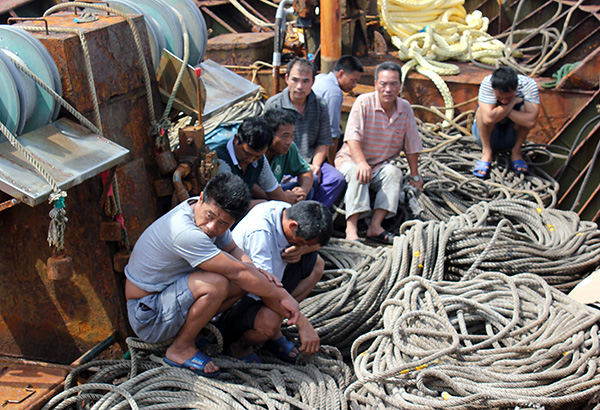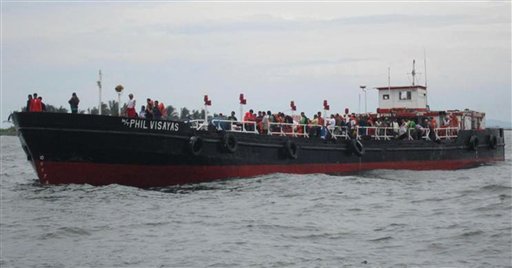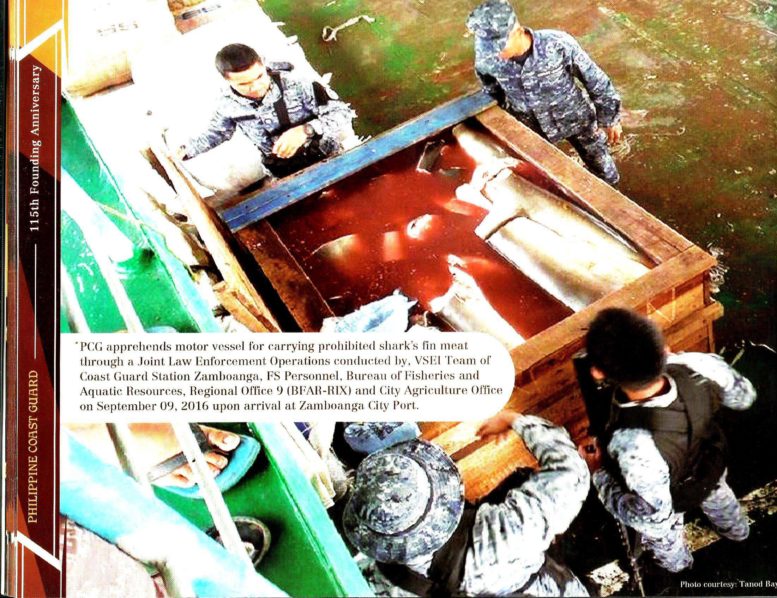Maritime law enforcement maybe broadly defined as the coordinated efforts by government enforcement agencies to prevent, detect and suppress violations of maritime laws and their concomitant rules and regulations. This definition intentionally excludes the other pillars of law enforcement such as the court, rehabilitation centers and the community and focuses on the people duly authorized to enforce the law in the maritime domain.
Prevention entails constant presence of and public information dissemination by law enforcers to dissuade violators. Detection involves employment of physical senses and electronic means to discover the violations of the law. Suppression is the actual application of reasonable force to arrest the violators, and to seize the evidence of such violation. Each of these actions requires physical, financial and human resources that determines the efficacy of the enforcement policy.
This article reviews the basic features of maritime law enforcement, cites some challenges, and suggests strategies to enhance maritime law enforcement.
Features of Maritime Law Enforcement. The sea is the center of maritime activities. It is a source of food, power and energy. The sea also provides a line of communication between islands and nations, and carries over 80% of the world’s trade commodities. While the sea is commonly used to establish geographical boundaries of many nation-states it also connects them. Given the vastness of the sea, the varied territorial claims by coastal states, and the institutionalization of international human rights law, enforcing the law in the maritime environment inevitably becomes very challenging.
There are five features of maritime law enforcement: authority, surveillance, apprehension, prosecution, and disposition.
Authority is the power to judge, act or command, and necessarily requires extensive knowledge of the laws, rules and regulations. Enforcement consists of three categories: (1) area of jurisdiction; (2) person or thing; and (3) offense or violation. The 1982 United Nations Law of the Sea is one of the many laws that vests a coastal state authority to enforce its laws pertaining to customs, immigration, quarantine, fishery, marine pollution, etc. in specified geographical areas adjacent to it. At the high seas, the coastal state exercises the right to visit merchant vessels under the following circumstances: a) engaged in slave trade; b) engaged in piracy; c) engaged in illegal broadcasting; d) without nationality; and e) displaying a flag other than the ship’s state flag.
Surveillance is the act of ascertaining the violation through observance of facts. It normally starts with intelligence reports or formal requests from principal agencies mandated to implement special laws. After collaboration with other intelligence agencies the tasked law enforcement unit conducts actual verification. Once on the scene, visual detection is the most common way to discover the violation. If boarding the suspect vessel is the necessary and proper interdiction, then boarding procedures must be followed to the letter to avoid any untoward incidents.
Apprehension is the next step in enforcement once surveillance is completed. This requires minimum amount of force to protect the enforcers, placing the suspects under custody, and gathering evidence of the violation. Vital data needed upon apprehension include the actual location and time of arrest, vessel name and nationality, crew and passengers, cargo manifest, and port of origin and destination. At this stage, enforcers must observe proper procedures to avoid human rights curtailment and preserve the evidence of the violation. Unless armed with a search warrant, inspection officers must observe the Miranda Doctrine in conducting search aboard the vessel.
Prosecution is the process of resolving the violation after the apprehension. Right after the arrest of suspects and the gathering of evidence the enforcement team shall conduct tactical interrogation to initially determine the probable cause to warrant elevation to the prosecutor’s office. For serious violations like piracy, slave trading, illegal broadcasting against the coastal state, and smuggling of contraband goods (prohibited drugs, WMD, firearms, etc.) the conveyance vessel maybe detained in the nearest port. The task of the arresting officers shall be to serve as witnesses during preliminary investigation and court trial, and to present the evidence in their original form and quantity.
Disposition is the act of implementing the court decision. It also involves the recording of the entire proceedings for analysis that should usher policy and procedural changes and for future reference. Disposition gauges the success or failure of the enforcement efforts.
Challenges. Each of the five features enumerated above pose several challenges. The authority to enforce laws in the maritime environment emanates from the legislature that assigns the implementation of such laws to specific agencies under the executive branch of government. But most of these agencies have limited capability and so they deputize the uniformed services with sea going assets like the coast guard, the navy, and the maritime police. Since these uniformed services have their primary functions, their assistance to requesting agencies depends on the nature, criticality and location of the violations, and the availability of ships and aircraft.
In the past, the National Law Enforcement Coordinating Committee (NALECC) served as coordinative body to align the government law enforcement plans, programs and activities at the national level. NALECC’s collective decisions were cascaded down to the regional and provincial levels. The Philippine Navy took the lead in the maritime domain with its patrol vessels and the coast guard units stationed ashore. Former President Fidel V Ramos, then Chief of Philippine Constabulary, was founding chair of NALECC. Commodore Carlos L Agustin was one of FVR’s staff during those days.
In 2011, the government institutionalized the National Coast Watch System (NCWS) that traces its beginnings in the Philippine Navy as far back as the seventies. The principal decision-making body is a council consisting of 9 line department secretaries and the executive secretary. Its implementer is the National Coast Watch Center whose main task is coordinating maritime security operations including maritime law enforcement. Failure to promptly monitor, if not prevent, the 2013 intrusion by Sulu Sultanate warriors into Lahad Datu in Sabah, Malaysia demonstrates the gap between concept and implementation.
Surveillance is hampered by the expanse of the country’s maritime territory and the limited capability of the enforcement agencies. The number of coast watch stations is inadequate and their operational availability is far from desirable. There are neither satellite-based surveillance systems nor drones to monitor jurisdictional waterways, including EEZs, contiguous zones, and anchorages. Real time coordination is far from ideal. Interoperability among the three uniformed maritime enforcement units needs a serious examination.
It is in the area of apprehension where many challenges occur. They may be classified as personal and organizational. On organizational, the first would be intervention from higher authorities. The actions of the apprehending officers, considered agents of law, are normally guided by doctrines and rules of engagement (ROE). Problems occur when higher authorities without amending those guidelines intervene for no justifiable reason.
A sad point to mention is the June 2012 incident in Scarborough Shoal. Before that, fishing boats from Philippines and China would frequent the shoal as a matter of peaceful coexistence because of abundant resources therein. Apart from deriving mutual benefits, their presence served as check and balance to regulate fishing activities.
On that fateful day, a Philippine Navy boarding team inspected a Chinese fishing vessel that was not in the act of fishing but only lying near the mouth of the shoal. While the Philippines can invoke the regime of island doctrine by virtue of RA 9522 approved in 2009 to board foreign vessels in the area, China has a standing “9-dash line” claim that includes Scarborough Shoal many years ahead of the new Philippine baseline law. Some books even cite Scarborough Shoal as one of the world’s flash points because of conflicting ownership claims. The order to board and search apparently came from higher authorities probably to test both the implementation of the baseline law and China’s resolve to protect their 9-dash line claim or to please a party with vested interest. The boarding team returned to their ship and the naval patrol left the shoal without replacement.
The result was catastrophic. The Philippines lost control of a piece of territory without any fight thereby denying the local fishermen a significant source of income from fishing. The UN Permanent Court of Administration’s decision will not change the current situation in the shoal unless China voluntarily relinquishes physical control of Scarborough.
The second challenge would be the impractical detention period of arrested persons that gives a maximum of only 36 hours to the law enforcers to hold the suspects. Sea patrols are normally undertaken in areas far from the courts. Law enforcement units are liable to be charged with arbitrary detention and such concern could affect the motivation to enforce the law.
The third challenge would be how to increase the operational availability of law enforcement assets, for the interdiction of vessels and crafts. In the past, the navy utilized its floating assets in accordance with Deploy-Maintain-Repair-Train (DMRT) cycle. Fully operational ships were deployed in designated sea areas and the crew undertook planned maintenance to keep the ships in shape. Ships facing major derangement requiring depot-level repair are sent to the shipyard. The repair period is used to train the crew to prepare for the next deployment. This DMRT cycle ushered the culture of maintenance in the navy.
The personal level challenge that tops the list is individual training. Such training involves activities to learn trade skills especially customs, immigration and quarantine (CIQ) and fishery laws, inject positive attitude and influence habits. The quality and frequency of training of the enforcers are important determinants of effective maritime law enforcement. Many cases have been lost due to technicalities. Procedures are not strictly followed in some cases because of unforeseen circumstances or unfamiliarity with maritime law.
In 1985, then Lt. Emilio Marayag, Davao PCG Commander, apprehended a tugboat with around 300 wooden logs off Samal Island in Davao Gulf. He decided to have the tugboat and its towed cargo anchor off Santa Ana pier. The next day, he received a release order from headquarters citing a memo from one of the offices in DENR. But before he could ascertain the veracity of the order, he received another order contravening the previous order. This time, the reference was a memo from the DENR Secretary’s office. With conflicting directives, he had to hold on to the confiscated items. Ultimately, what prevailed was an act of nature -a strong squall- that resolved the issue. The logs parted from their lines and got scattered along the nearby shoreline. Both tugboat operator and owner were fined for towing the improperly documented timber.
Apart from individual training, inter-agency training is necessary for both the uniformed services and the agencies that deputize the uniformed agents of law.
Another challenge is corruption. Considered a social cancer, corruption permeates many organizations especially those involved in law enforcement. Violations continue not only because the violators want to earn more money or derive more favor but also because those entrusted to arrest them condone the violations for personal benefit. Corruption happens when the agents have the opportunity by virtue of their positions to discover, stop or perpetrate violations. Once attracted to easy money or reward, and receive such, they become corrupt. As they continue with this illegal practice, they rationalize their actions by saying that everybody is doing it anyway. Bribery and harassment are the most common techniques used to corrupt the enforcers.
The third is committing a violation to extract information from the violators to build up a case. Interrogation officers in some instances violate the human rights of the suspects to get vital information.
The law enforcers’ role during the prosecution is to stand as witnesses. The challenges include sustained presence during the court trials. Due to administrative, operational and financial requirements, many law enforcer-witnesses fail to attend the court proceedings. Their personal testimonies influence the decision of the court. The judge who schedules the trial, hears the case, weighs the evidence and issues the verdict needs first hand evidence usually provided by witnesses to make unbiased decision. The large volume of court cases can prolong court proceedings, which in turn dissipate the financial resources and interest of the witnesses.
The disposition of a maritime case is dependent on the court decision. There are attendant matters that law enforcers must deal with to orderly dispose the case. One is the custody of the arrested persons. While the arresting officers may commit them to the jail agency, their physical security is always a concern as in the recent case of town mayor who was killed while in prison. The storage and preservation of the evidence is another. Where will they be deposited and how will they be brought to court to avoid tampering and loss of evidentiary material?
In sum, maritime law enforcement challenges revolve around resource allocation for doctrine formulation, detection, command and control equipment, extensive training and continuous motivation of the enforcers, and readily accessible support personnel to build up the case from apprehension to disposition.

Philippine Coast Guard arrest Chinese fishermen who rammed a PCG
vessel. Photo credit: philstar.com
Suggested Strategies. Law enforcement efforts require strong coordination, cooperation and collaboration between and among the different government agencies. With sea territory larger than its land area, the Philippines needs a clear maritime strategy to protect, defend, exploit and preserve its maritime areas.
This maritime strategy must emphasize that the country is an archipelago that depends on unimpeded use of the sea not only to extract the fishery and aquatic resources and the minerals beneath the seabed but also for movement of goods and services for economic sustainability. A change in mindset of the population and the country’s leaders from land-based to maritime-based economy and security may shift government programs and budget allocation. To stress this point, Britain in the later part of the 17th century gave around 80% of its national budget to its Navy to protect its maritime interest that coincided with its national interest.
The nation’s maritime strategy must recognize three components: (1) a large and flourishing merchant fleet; (2) a credible navy or sea going armed force to insure freedom of navigation and protect the merchant fleet; and (3) a string of mobile or fixed bases or stations to provide logistics to the navy or sea-going force, and monitor the movement of vessels traversing the sea.
Enforcement of laws is intended to allow the merchant fleet vessels to do legitimate business free from harm, avoid safety-related accidents involving persons and vessels, and to protect the marine environment from degradation. Pending the creation of a body to oversee strict and sustained compliance to all applicable laws, the National Coast Watch Council with its secretariat and center may be clothed with additional powers to implement the maritime strategy.

Philippine Coast Guard rescues 178 passengers from sinking ship (MV Asia
Malaysia) in 2011. Photo credit: AP News & Asian Correspondent.com.
Beyond structural change at the topmost hierarchy, the maritime law enforcement agencies must acquire affordable capabilities to enhance their interoperability and information sharing. This would entail training in boarding and search procedures, human rights, evidence collection and preservation, violation detection, reporting system, records management, and Rules of Engagement. The Council may influence the Agency Heads to tailor procurement to improve capability to coordinate and operate at ground level.
Professional jealousy must be replaced by “team spirit” as espoused by former President Fidel Ramos who compares the country to a ship where harmony, teamwork and foresight propel it to the intended destination. Synergy can be achieved only by setting aside personal differences of the leaders in the enforcement agencies.
At the operational level the enforcement units may organize themselves to conduct periodic tabletop exercises and initiate limited exercises at sea to test respective or joint doctrines. They may start with inter-agency informal or formal meetings to be familiar with each other’s mandate and capabilities.
During then RADM Emilio Marayag’s stint as Commander, Naval Forces Western Mindanao in 2007-2008, he invited nearly all government agencies including the governors of the 3 island-provinces of Basilan, Sulu and Tawi-tawi for inter-agency meetings and consultations. The actual test of such interactions occurred during their participation in the periodic Philippine-Malaysia Border Patrol Operations. Before actual operations, both countries established clear-cut protocols to undertake specific tasks. In those border operations, none of those apprehended at sea filed any complaint of violations of human rights or harassment perpetrated by the participating units.
The present court system may not be able to efficiently handle maritime cases should our enforcement units level up their capabilities. In the previous issue of the Maritime Review there was a proponent, Daisy Arcilla Brett-Holt, who has been working hard for several years to establish the Jury System to expedite resolution of cases before the courts. This is one proposal worth exploring in the near future.
Maritime law enforcement units must forge a common doctrine for operations to avoid conflict and misunderstanding. They can consider plan-prepare-execute-assess cycle with special attention to human rights protection as one of the principles in their operational planning. One veteran constabulary officer once said something to this effect: the true gauge of success in law enforcement is not the number of apprehensions made but the number of cases won in the court of law.
